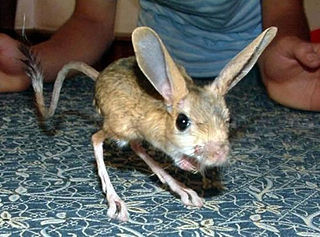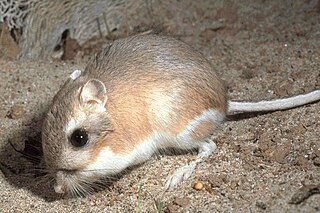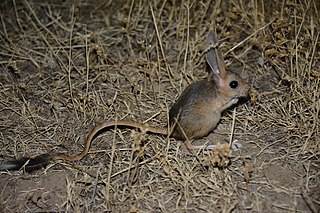
Jerboas are hopping desert rodents found throughout North Africa and Asia, and are members of the family Dipodidae. They tend to live in hot deserts.

Kangaroo rats, small mostly nocturnal rodents of genus Dipodomys, are native to arid areas of western North America. The common name derives from their bipedal form. They hop in a manner similar to the much larger kangaroo, but developed this mode of locomotion independently, like several other clades of rodents.

The four-toed jerboa is a rodent of the family Dipodidae and genus Scarturus that has four digits. Four-toed jerboas are native to Egypt and Libya. They live in coastal salt marshes and dry deserts.

Zapodidae, the jumping mice, is a family of mouse-like rodents in North America and China.

Dipodoidea is a superfamily of rodents, also known as dipodoids, found across the Northern Hemisphere. This superfamily includes over 50 species among the 16 genera in 3 families. They include the jerboas, jumping mice, and birch mice. Different species are found in grassland, deserts, and forests. They are all capable of saltation, a feature that is most highly evolved in the desert-dwelling jerboas.

The genus Allactaga contains the five-toed jerboas of Asia. They are small mammals belonging to the order of rodents. They are characteristically known as the hopping rodents of the desert and semi-arid regions. They have long hind feet, short forelimbs, and walk upright. They have large ears in comparison to their body size and a large tail. The tail assists and serves as support when the jerboa is standing upright. The jerboa body length ranges from 5–15 cm and has a tail ranging from 7–25 cm. The "forelimbs of the jerboa serve as a pair of hands for feeding, grooming, etc." Jerboas use their nose to burrow and push the dirt when looking for food. The male jerboa is usually larger in size and weight in comparison to the female jerboa. The pelt of the jerboa is either silky or velvety in texture and light in color, the coloration helps camouflage into surroundings to avoid predators. All members of the genus have five toes.
The Iranian jerboa is a rodent of the family Dipodidae and subfamily Allactaginae. They are characteristically known as hopping rodents and have only been found in a small population in Iran. Iranian jerboa are microhabitat specialist, they require a particular environment to provide them with specific conditions suitable for living.

The lesser jerboa is a small rodent of Africa and the Middle East. Its diet consists mainly of seeds and grasses.

The Libyan jird is a species of rodent in the family Muridae. It is found in Mauritania, Morocco, Algeria, Tunisia, Libya, Egypt, Jordan, Syria, Saudi Arabia, Iran, Iraq, Afghanistan, Turkmenistan, Uzbekistan, Kazakhstan and Western China. Its natural habitats are subtropical or tropical dry shrubland, intermittent saline lakes, hot deserts, and rural gardens.
The Balikun jerboa is a species of rodent in the family Dipodidae. It is found in arid areas of northwestern China and Mongolia. It eats green plants, plant roots, seeds, grasshoppers and beetles.
The Gobi jerboa is a species of rodent in the family Dipodidae. It is found in China and Mongolia. Its natural habitats are temperate grassland and temperate desert.
The Euphrates jerboa is a rodent of the family Dipodidae and genus Scarturus. They are characteristically known as hopping rodents. They have been found in Pakistan, Afghanistan, Iran, Iraq, Jordan, Kuwait, Saudi Arabia, Syria, and also occurs very marginally in southeastern Turkey. The Euphrates jerboa's natural habitats are semi-deserts, subtropical or tropical dry lowland grassland and hot deserts.

Merriam's kangaroo rat is a species of rodent in the family Heteromyidae. The species name commemorates Clinton Hart Merriam. It is found in the Upper and Lower Sonoran life zones of the southwestern United States, Baja California, and northern Mexico.

The greater Egyptian jerboa is a species of rodent in the family Dipodidae. It is found in Algeria, Egypt, Libya, Morocco, Saudi Arabia, Tunisia, and is possibly extinct in the Negev Desert of Israel. Its natural habitats are subtropical or tropical dry shrubland, sandy shores, and arable land.

Allactaginae is a subfamily of rodents.

Williams's jerboa is a species of jerboas native to Afghanistan, Armenia, Azerbaijan, Iran and Turkey.













